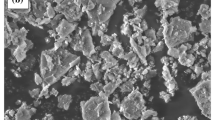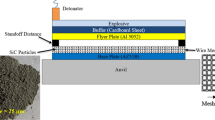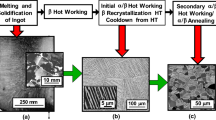Abstract
Discontinuously reinforced metal-matrix composites (MMCs) have extensive potential for use in structural applications at elevated temperatures. However, any use at high temperatures will require a detailed understanding of the creep characteristics of the MMCs and especially the dependence of the measured creep rates on the magnitudes of the applied stress and the testing temperatures. This report examines these characteristics with special reference to the well-documented creep behavior of conventional solid-solution alloys. It is shown that creep of these MMCs is controlled by deformation in the matrix alloys and this deformation may be interpreted using a similar approach to that already developed for the creep of solid solution alloys. However, additional parameters must be considered in analyzing the creep of MMCs, including the possible presence of a threshold stress and the potential for load transfer and additional substructural strengthening.
Similar content being viewed by others
References
T.G. Langdon, Metall. Mater. Trans. A, 33A (2002), pp. 249–259.
P. Yavari, F.A. Mohamed and T.G. Langdon, Acta Metall., 29 (1981), pp. 1495–1507.
F.A. Mohamed and T.G. Langdon, Acta Metall., 22 (1974), pp. 779–788.
P. Yavari and T.G. Langdon, Acta Metall., 30 (1982), pp. 2181–2196.
Z. Horita and T.G. Langdon, Proc. 7th Int. Conf. Strength of Metals and Alloys (ICSMA 7), ed. H.J. McQueen et al. (Oxford, England: Pergamon Press, 1985), vol. 1, pp. 797–802.
T.G. Nieh, K. Xia, and T.G. Langdon, J. Eng. Mater. Technol., 110 (1988), pp. 77–82.
K.-T. Park, E.J. Lavernia, and F.A. Mohamed, Acta Metall., 38 (1990), pp. 2149–2159.
Y. Ma and T.G. Langdon, Mater. Sci. Eng., A230 (1997), pp. 183–187.
Y. Li and T.G. Langdon, Acta Mater., 45 (1997). pp. 4797–4806.
Y. Li and T.G. Langdon, Metall. Mater. Trans., A 29A (1998), pp. 2523–2531.
J.E. Bird, A.K. Mukherjee, and J.E. Dorn, Quantitative Relation Between Properties and Microstructure, ed. D.G. Brandon and A. Rosen (Jerusalem: Israel Universities Press, 1969), pp. 255–341.
K.-T. Park, E.J. Lavernia, and F.A. Mohamed, Acta Metall., 42 (1994), pp. 667–678.
J.C. Gibeling and W.D. Nix, Mater. Sci. Eng., 45 (1980), pp. 123–135.
A.B. Pandey, R.S. Mishra, and Y.R. Mahajan, Acta Metall. Mater., 40 (1992), pp. 2045–2052.
B.Y. Lou et al., Mater. Trans., 43 (2002), pp. 501–509.
Y. Li and T.G. Langdon, Acta Mater., 46 (1998), pp. 1143–1155.
J. Cadek et al., High Temp. Mater. Process., 13 (1994), pp. 327–338.
J. Cadek, H. Oikawa, and V. Šustek, Mater. Sci. Eng., A198 (1995), pp. 9–23.
Y. Li and T.G. Langdon, Scripta Mater., 36 (1997), pp. 1457–1460.
R. Lagneborg and B. Bergman, Metal Sci., 10 (1976), pp. 20–28.
A. Kelly and K.N. Street, Proc. R. Soc. (London) A, 328A (1972), pp. 267–282.
A. Kelly and K.N. Street, Proc. R. Soc. (London) A, 328A (1972), pp. 283–293.
Y. Li and T.G. Langdon, Acta Mater., 47 (1999), pp. 3395–3403.
B.Q. Han and T.G. Langdon, Mater. Sci. Eng., A322 (2002), pp. 73–78.
H. Li et al., J. Mater. Sci. Lett., 15 (1996), pp. 616–619.
N. Shi et al., Metall. Mater. Trans. A, 28A (1997), pp. 2741–2753.
S. Spigarelli et al., Mater. Sci. Eng., A328 (2002), pp. 39–47.
Z. Lin, Y. Li, and F.A. Mohamed, Mater. Sci. Eng., A332 (2002), pp. 330–342.
L. Kloc et al., Mater. Sci. Eng., A216 (1996), pp. 161–168.
L. Kloc et al., Acta Mater., 45 (1997), pp. 529–540.
A.B. Pandey, R.S. Mishra, and Y.R. Mahajan, Metall. Mater. Trans. A, 27A (1996), pp. 305–316.
Author information
Authors and Affiliations
Additional information
For more information, contact T.G. Langdon, University of Southern California, Departments of Aerospace and Mechanical Engineering and Materials Science, Los Angeles, CA 90089-1453, (213) 740-0491; fax (213) 740-8071; e-mail langdon@usc.edu.
Rights and permissions
About this article
Cite this article
Huang, Y., Langdon, T.G. The creep behavior of discontinuously reinforced metal-matrix composites. JOM 55, 15–20 (2003). https://doi.org/10.1007/s11837-003-0187-7
Issue Date:
DOI: https://doi.org/10.1007/s11837-003-0187-7




